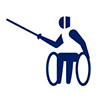 a Summer Games Paralympic Sport
a Summer Games Paralympic SportGoverning Bodies
International Governing Bodies

International Wheelchair and Amputee Sports Federation (IWAS)
National Governing Bodies
United States

USA Parafencing
Introduction:
Wheelchair fencing is a version of fencing for athletes with a disability.
Fencing is a combat sport that features sword fighting. The three disciplines of modern fencing are the foil, the épée, and the sabre (also saber); each discipline uses a different kind of blade, which shares the same name, and employs its own rules. Most competitive fencers specialize in one discipline. The modern sport gained prominence near the end of the 19th century and is based on the traditional skill set of swordsmanship. The Italian school altered the historical European martial art of classical fencing, and the French school later refined that system. Scoring points in a fencing competition is done by making contact with an opponent.
History of the Sport:
Wheelchair fencing was developed at Stoke Mandeville Hospital after World War II, first to aid the recovery of spinal cord injury patients by strengthening their muscles and improving their balance.
Wheelchair Fencing made its debut in the Stoke Mandeville Games in 1953, a competition especially for war veterans. The first countries to develop the sport were precisely those with a tradition in world fencing: England, France and Italy.
Wheelchair fencing soon became very popular and the discipline was included in the first ever Paralympic Games in 1960. The original program only included saber events in Rome., but based on the regulations of the International Fencing Federation (FIE, in French), two more weapons were introduced—foil and epée—in the Tokyo Games four years later.
Rules – How to Play the Sport:
The rules of wheelchair fencing are generally the same as those for its Olympic equivalent; it differs, however, in that fencers only use the upper half of their bodies to battle. The distance between the two fencers is determined by the one with the shorter arm reach. The fencers are positioned according to whether they are right or left handed. During a bout, the fencer holds their weapon with one hand, using the other to hold on to their wheelchair during attack and recovery. The fencer must remain seated and keep their feet on the footrest.
In foil bouts, the target area is limited to the opponent’s trunk. In sabre bouts, the target area is any part of the body above a horizontal line drawn between the top of the folds formed by the thighs and trunk of the fencer. In épée bouts, the whole body above the hips is a target area. Fencers wear a metal apron to ensure that hits to off-target areas are not counted.
Only people with locomotor disabilities may compete in Wheelchair Fencing; the most common are amputations, paraplegia, congenital malformations and strokes. Categories are divided according to each athlete’s balance in the wheelchair, and the condition of the arm which will wield the weapon. The eligible impairments at the 2024 Paris games include: orthopaedic impairments, paraplegia, quadriplegia, hemiplegia, cerebral palsy, degenerative neurological disorders and neurological disabilities.
Classification
- class A (athletes with full trunk movement and good balance)
- class B (athletes with no leg movement and impaired trunk and balance functions)
- class C (athletes with a disability in all four limbs, not included in the Paralympic games program)
The equipment required for the sport includes a mask, jacket and protective gloves. In a foil match, there is a protective shield for the chair’s wheels. In epée disputes, a metal apron is used to protect the competitor’s legs and the wheels of the chair.
The competition area is 4 meters long by 1.5 m wide. Using special sensors, the fencers are connected to an electronic counting system, which indicates whether a touch is valid and, based on this, the referee decides whether or not it earns a point, and for which athlete in the case of a double touch.
Each of the weapons used has its own scoring area: the foil is limited to the trunk, not including the arms and head, while in epée touches are valid from the waist up, including the arms and mask. With the saber, touches are allowed with any part of the blade (tip and edges) and the valid target is the entire surface area from the waistline up, including arms and mask.


